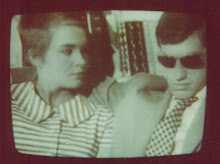Somehow I missed the phenomena of Daniel Johnston, who gained fame in the Austin alternative music scene during the mid-1980s and beyond. I stumbled upon a preview of this film and immediately requested the DVD. As an artist, art therapist and lover of outsider art, I became quickly became consumed by this story of madness, creativity and love.
Jeff Feurzeig’s documentary weaves film footage collected by Johnston and his family—with interviews and commentary by the many people who were touched by him. He was forty-five at the time of the film's release. We see footage of him a few years earlier performing at the 2001 Austin Music Awards Show, when he won Best Songwriter of the Year. He had become quite heavy and aged by the mental illness that fueled his creativity. Wildly popular in Austin, the attention he received was also quite controversial. The bipolar genius singer/songwriter/artist expressed his talent in ways that were often more spectacle than art.
Johnston’s elderly parents, Bill and Mabel, are featured extensively as they demonstrate unending care and support for their son, the youngest of five children who was always different. They lived an ordinary family life in West Virginia during the 60s and 70s. An expressive and confident child--by junior high school, his illness began to come out in ways that made him more difficult to live with. He rarely slept durih ng his constant occupation with drawing, recording and filming in his basement "art factory." He shunned the fundamentalist Christian views of his family, but as his illness worsened, religious delusions increased (ie: the devil). During high school he began drawing eyeballs—the image became his trademark. Daniel fell in love with a girl named Laurie who broke his heart when she took up with a new boy and got married. Many of his songs were about how he pined for her.
He tried college for awhile, but the parents took him out when it was apparent that he was not succeeding there. A couple of his siblings invited him into their homes at various times to attempt to provide a stable environment and “normal” life. He thrived while living with his sister and working at the local amusement park—until the day he bought a moped and went on the road with a carnival for several months. The family was sick with worry until they found him in Austin, working at MacDonald’s while making his way into the growing music scene.
Hi How Are You? Is Johnston’s first album in the genre of Meet The Beatles. He adored them and believed he would one day be just as famous. He discovered a local band called Glass Eye and felt some kind of cosmic connection with them because of his eyeball fascination and was invited to open for the band. Lead singer, Katy McCarty took a liking to him and soon Johnston considered her his new girlfriend. She went along for awhile until he began referring to her as his fiancée. She had to put an end it, another heart-breaking event that Johnston would pine over for years to come, adding material to his heartfelt songwriting.
He was featured on MTV, the realization of one of his dreams. Jeff Tartakov was a fan turned advocate who formed Stress Records to help Johnston market the licensing of his songs to other musicians. He also began using LSD and experiencing further mental breakdown leading to a violent attack to his manager. By this time, Johnston had been in and out of psychiatric facilities and on and off various medications. After recovering from one of his low points, Johnston was invited by Steve Shelly of Sonic Youth to record at Noise Studio in the late 1980s. While in New York, he got arrested for drawing hundreds of christian fish symbols at the Statue of Liberty.
The film is full of dramatic stories about Johnston’s out-of-control life, including an incident told about by Johnston senior--while piloting a small aircraft to take Dan home after The Austin Music Awards, Dan pulled the key from the ignition and tossed it out the window of the plane and wrestled the controls away from Bill. The two were heading for a crash when Bill was able to regain control for a safe landing into a group of trees.
The Johnstons moved to Walley, Texas during the early 90s. Dan was championed by Curt Cobain of Nirvana during that decade. He religiously wore the t-shirt design for Dan's first album. This attention brought Johnston unprecedented notoriety. He actually sparked a bidding war as a $100,000 contract was negotiated from the visitors area of the state mental hospital. Atlantic Records actually constructed the most beneficial plan for Johnston, fully incorporating the demands of his illness with clauses for the special provisions. By this time in Johnston’s career, Jeff Tartakov had stepped in as manager. He lived for the good of Dan Johnston. Sadly, Johnston turned on him just as his Atlantic Records contract was signed when he fired Tartakov and hired a new manager.
Johnston’s “FUN” was released in 1994 an the label dropped him soon after. Bill and Mabel never give up on their son. At the end of the film, he was living in their basement as he had as a teenager with another version of his art factory. They manage a bit of peace and quiet during the morning hours, but once Dan arises, he demands to be cooked for and taken places. He played with a band living down the street—Nightmare House.
More than 150 bands have recorded his songs. This is a fascinating story and tribute to the creative life.




